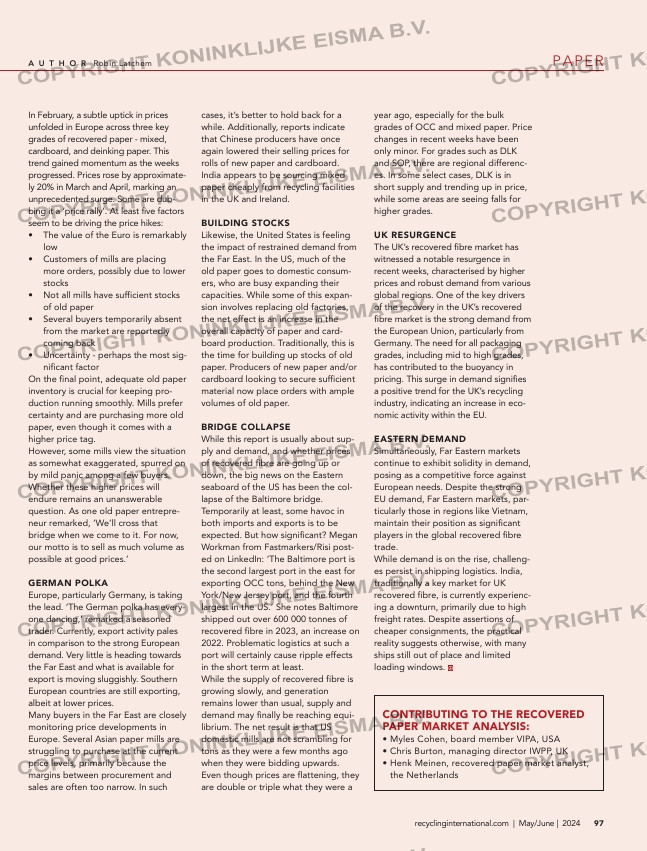Page 97 from: What’s inside?

PAPER
97recyclinginternational.com | May/June | 2024
CONTRIBUTING TO THE RECOVERED
PAPER MARKET ANALYSIS:
• Myles Cohen, board member VIPA, USA
• Chris Burton, managing director IWPP, UK
• Henk Meinen, recovered paper market analyst,
the Netherlands
year ago, especially for the bulk
grades of OCC and mixed paper. Price
changes in recent weeks have been
only minor. For grades such as DLK
and SOP, there are regional differenc-
es. In some select cases, DLK is in
short supply and trending up in price,
while some areas are seeing falls for
higher grades.
UK RESURGENCE
The UK’s recovered fibre market has
witnessed a notable resurgence in
recent weeks, characterised by higher
prices and robust demand from various
global regions. One of the key drivers
of the recovery in the UK’s recovered
fibre market is the strong demand from
the European Union, particularly from
Germany. The need for all packaging
grades, including mid to high grades,
has contributed to the buoyancy in
pricing. This surge in demand signifies
a positive trend for the UK’s recycling
industry, indicating an increase in eco-
nomic activity within the EU.
EASTERN DEMAND
Simultaneously, Far Eastern markets
continue to exhibit solidity in demand,
posing as a competitive force against
European needs. Despite the strong
EU demand, Far Eastern markets, par-
ticularly those in regions like Vietnam,
maintain their position as significant
players in the global recovered fibre
trade.
While demand is on the rise, challeng-
es persist in shipping logistics. India,
traditionally a key market for UK
recovered fibre, is currently experienc-
ing a downturn, primarily due to high
freight rates. Despite assertions of
cheaper consignments, the practical
reality suggests otherwise, with many
ships still out of place and limited
loading windows.
cases, it’s better to hold back for a
while. Additionally, reports indicate
that Chinese producers have once
again lowered their selling prices for
rolls of new paper and cardboard.
India appears to be sourcing mixed
paper cheaply from recycling facilities
in the UK and Ireland.
BUILDING STOCKS
Likewise, the United States is feeling
the impact of restrained demand from
the Far East. In the US, much of the
old paper goes to domestic consum-
ers, who are busy expanding their
capacities. While some of this expan-
sion involves replacing old factories,
the net effect is an increase in the
overall capacity of paper and card-
board production. Traditionally, this is
the time for building up stocks of old
paper. Producers of new paper and/or
cardboard looking to secure sufficient
material now place orders with ample
volumes of old paper.
BRIDGE COLLAPSE
While this report is usually about sup-
ply and demand, and whether prices
of recovered fibre are going up or
down, the big news on the Eastern
seaboard of the US has been the col-
lapse of the Baltimore bridge.
Temporarily at least, some havoc in
both imports and exports is to be
expected. But how significant? Megan
Workman from Fastmarkers/Risi post-
ed on LinkedIn: ‘The Baltimore port is
the second largest port in the east for
exporting OCC tons, behind the New
York/New Jersey port, and the fourth
largest in the US.’ She notes Baltimore
shipped out over 600 000 tonnes of
recovered fibre in 2023, an increase on
2022. Problematic logistics at such a
port will certainly cause ripple effects
in the short term at least.
While the supply of recovered fibre is
growing slowly, and generation
remains lower than usual, supply and
demand may finally be reaching equi-
librium. The net result is that US
domestic mills are not scrambling for
tons as they were a few months ago
when they were bidding upwards.
Even though prices are flattening, they
are double or triple what they were a
A U T H O R Robin Latchem
In February, a subtle uptick in prices
unfolded in Europe across three key
grades of recovered paper – mixed,
cardboard, and deinking paper. This
trend gained momentum as the weeks
progressed. Prices rose by approximate-
ly 20% in March and April, marking an
unprecedented surge. Some are dub-
bing it a ‘price rally’. At least five factors
seem to be driving the price hikes:
• The value of the Euro is remarkably
low
• Customers of mills are placing
more orders, possibly due to lower
stocks
• Not all mills have sufficient stocks
of old paper
• Several buyers temporarily absent
from the market are reportedly
coming back
• Uncertainty – perhaps the most sig-
nificant factor
On the final point, adequate old paper
inventory is crucial for keeping pro-
duction running smoothly. Mills prefer
certainty and are purchasing more old
paper, even though it comes with a
higher price tag.
However, some mills view the situation
as somewhat exaggerated, spurred on
by mild panic among a few buyers.
Whether these higher prices will
endure remains an unanswerable
question. As one old paper entrepre-
neur remarked, ‘We’ll cross that
bridge when we come to it. For now,
our motto is to sell as much volume as
possible at good prices.’
GERMAN POLKA
Europe, particularly Germany, is taking
the lead. ‘The German polka has every-
one dancing,’ remarked a seasoned
trader. Currently, export activity pales
in comparison to the strong European
demand. Very little is heading towards
the Far East and what is available for
export is moving sluggishly. Southern
European countries are still exporting,
albeit at lower prices.
Many buyers in the Far East are closely
monitoring price developments in
Europe. Several Asian paper mills are
struggling to purchase at the current
price levels, primarily because the
margins between procurement and
sales are often too narrow. In such
96-97_mapaper.indd 97 24-04-2024 14:33



